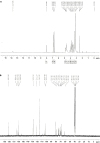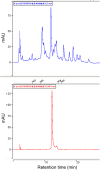Schaftoside Interacts With NlCDK1 Protein: A Mechanism of Rice Resistance to Brown Planthopper, Nilaparvata lugens
- PMID: 29896209
- PMCID: PMC5986872
- DOI: 10.3389/fpls.2018.00710
Schaftoside Interacts With NlCDK1 Protein: A Mechanism of Rice Resistance to Brown Planthopper, Nilaparvata lugens
Abstract
Brown planthopper (BPH) Nilaparvata lugens Stål is a serious insect pest of rice in Asian countries. Active compounds have close relationship with rice resistance against BPH. In this study, HPLC, MS/MS, and NMR techniques were used to identify active compounds in total flavonoids of rice. As a result, a BPH resistance-associated compound, Peak 1 in HPLC chromatogram of rice flavonoids, was isolated and identified as schaftoside. Feeding experiment with artificial diet indicated that schaftoside played its role in a dose dependent manner, under the concentration of 0.10 and 0.15 mg mL-1, schaftoside showed a significant inhibitory effect on BPH survival (p < 0.05), in comparison with the control. The fluorescent spectra showed that schaftoside has a strong ability to bind with NlCDK1, a CDK1 kinase of BPH. The apparent association constant KA for NlCDK1 binding with schaftoside is 6.436 × 103 L/mol. Docking model suggested that binding of schaftoside might affect the activation of NlCDK1 as a protein kinase, mainly through interacting with amino acid residues Glu12, Thr14 and Val17 in the ATP binding element GXGXXGXV (Gly11 to Val18). Western blot using anti-phospho-CDK1 (pThr14) antibody confirmed that schaftoside treatment suppressed the phosphorylation on Thr-14 site of NlCDK1, thus inhibited its activation as a kinase. Therefore, this study revealed the schaftoside-NlCDK1 interaction mode, and unraveled a novel mechanism of rice resistance against BPH.
Keywords: CDK1 protein; brown planthopper; flavonoids; interaction mechanism; rice; schaftoside; varietal resistance.
Figures










Similar articles
-
Mechanisms of callose deposition in rice regulated by exogenous abscisic acid and its involvement in rice resistance to Nilaparvata lugens Stål (Hemiptera: Delphacidae).Pest Manag Sci. 2017 Dec;73(12):2559-2568. doi: 10.1002/ps.4655. Epub 2017 Sep 12. Pest Manag Sci. 2017. PMID: 28664567
-
Recent Advances in Molecular Mechanism and Breeding Utilization of Brown Planthopper Resistance Genes in Rice: An Integrated Review.Int J Mol Sci. 2023 Jul 27;24(15):12061. doi: 10.3390/ijms241512061. Int J Mol Sci. 2023. PMID: 37569437 Free PMC article. Review.
-
Genomics of interaction between the brown planthopper and rice.Curr Opin Insect Sci. 2017 Feb;19:82-87. doi: 10.1016/j.cois.2017.03.005. Epub 2017 Mar 18. Curr Opin Insect Sci. 2017. PMID: 28521948 Review.
-
High-resolution mapping and breeding application of a novel brown planthopper resistance gene derived from wild rice (Oryza. rufipogon Griff).Rice (N Y). 2019 Jun 4;12(1):41. doi: 10.1186/s12284-019-0289-7. Rice (N Y). 2019. PMID: 31165331 Free PMC article.
-
Genetic basis of multiple resistance to the brown planthopper (Nilaparvata lugens Stål) and the green rice leafhopper (Nephotettix cincticeps Uhler) in the rice cultivar 'ASD7' (Oryza sativa L. ssp. indica).Breed Sci. 2015 Dec;65(5):420-9. doi: 10.1270/jsbbs.65.420. Epub 2015 Dec 1. Breed Sci. 2015. PMID: 26719745 Free PMC article.
Cited by
-
Rice functional genomics: decades' efforts and roads ahead.Sci China Life Sci. 2022 Jan;65(1):33-92. doi: 10.1007/s11427-021-2024-0. Epub 2021 Dec 7. Sci China Life Sci. 2022. PMID: 34881420 Review.
-
May phytophenolics alleviate aflatoxins-induced health challenges? A holistic insight on current landscape and future prospects.Front Nutr. 2022 Oct 28;9:981984. doi: 10.3389/fnut.2022.981984. eCollection 2022. Front Nutr. 2022. PMID: 36386916 Free PMC article. Review.
-
Global metabolite profiles of rice brown planthopper-resistant traits reveal potential secondary metabolites for both constitutive and inducible defenses.Metabolomics. 2019 Nov 19;15(12):151. doi: 10.1007/s11306-019-1616-0. Metabolomics. 2019. PMID: 31741127
-
Comprehensive transcriptomic analysis of three varieties with different brown planthopper-resistance identifies leaf sheath lncRNAs in rice.BMC Plant Biol. 2023 Jul 22;23(1):367. doi: 10.1186/s12870-023-04374-w. BMC Plant Biol. 2023. PMID: 37480003 Free PMC article.
-
Metabolic engineering to enhance the accumulation of bioactive flavonoids licochalcone A and echinatin in Glycyrrhiza inflata (Licorice) hairy roots.Front Plant Sci. 2022 Aug 18;13:932594. doi: 10.3389/fpls.2022.932594. eCollection 2022. Front Plant Sci. 2022. PMID: 36061790 Free PMC article.
References
-
- Bakhtiar A., Gleye J., Moulis C., Fourasté I. (1994). Desorption chemical ionization mass spectrometry of C-glycosylflavones. Phytochem. Anal. 5 86–89. 10.1002/pca.2800050208 - DOI
-
- Bottrell D. G., Schoenly K. G. (2012). Resurrecting the ghost of green revolutions past: the brown planthopper as a recurring threat to high-yielding rice production in tropical Asia. J. Asia Pac. Entomol. 15 122–140. 10.1016/j.aspen.2011.09.004 - DOI
LinkOut - more resources
Full Text Sources
Other Literature Sources
Research Materials
Miscellaneous

